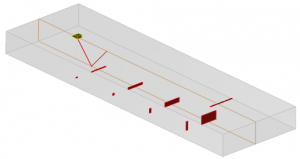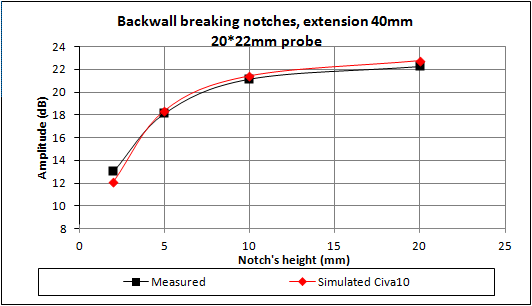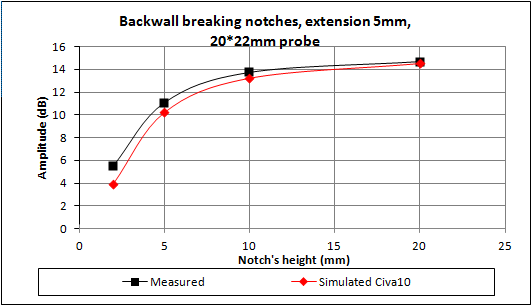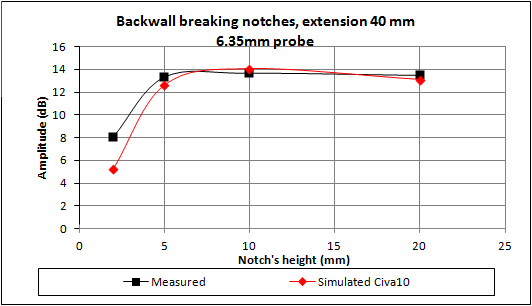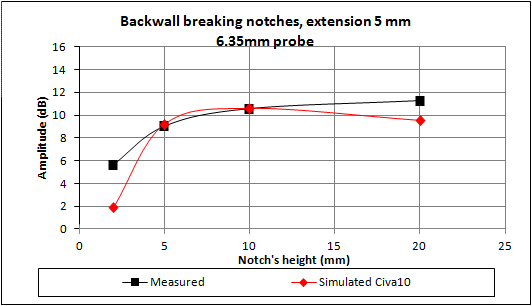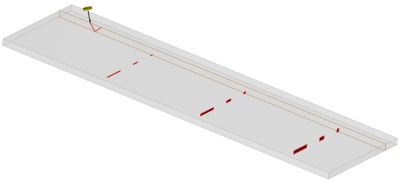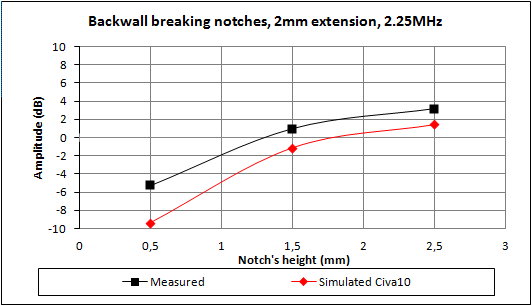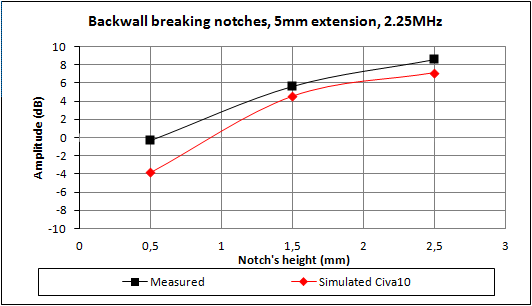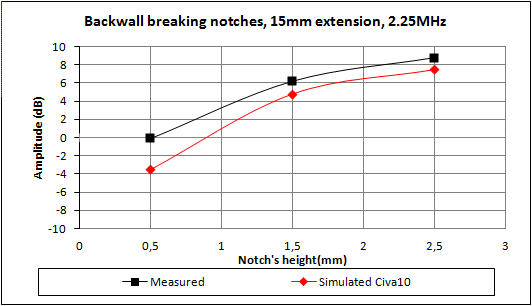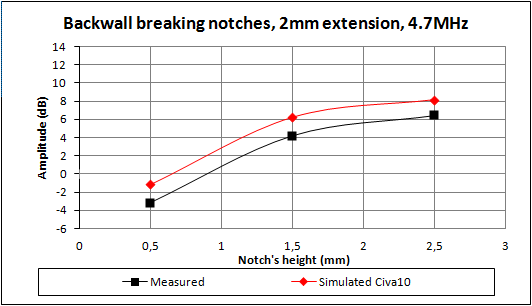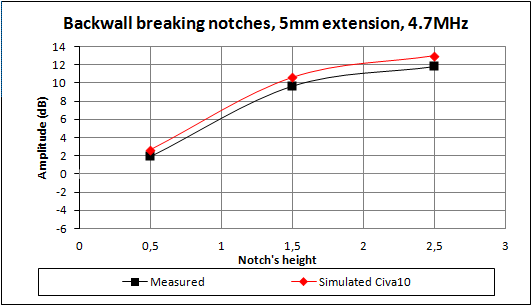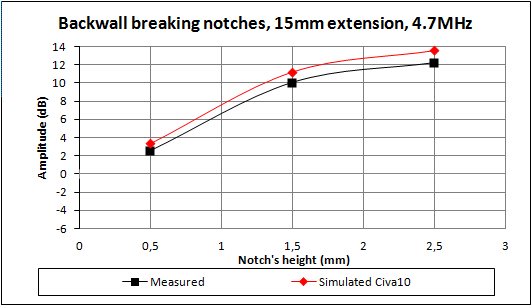UT – Corner echoes with SV mode: Simultaneous influence of the 2 dimensions of the notch
Summary
Two experiments have been performed in order to study the simultaneous influence of the notch dimensions, one with contact probes and one with immersion probes.
CONFIGURATION for CONTACT probes
To study the simultaneous influence of the two dimensions of a notch, inspections are performed on notches of 4 different heights and of 2 different lengths. The inspected mock-up is a planar stainless steel specimen containing two sets of notches of two different extensions: 5 mm and 40 mm. All notches are backwall breaking (specimen thickness of 50 mm). In each series, the notches have heights of 2 mm, 5 mm, 10 mm and 20 mm. The mock-up also contains a Ø2 mm SDH of 60 mm length and is located at 30 mm depth. It is used for calibration.
Two single element contact probes are used:
| Frequency | Crystal | Mode | Calibration depth |
| 2.0 MHz | 20 x 22 mm | SV45 | 30 mm |
| 2.25 MHz | Ø6.35 mm | SV45 | 30 mm |
Results for contact probes
The rectangular contact probe of 20 x 22 mm functioning at 2.0 MHz is used to perform a SV45 inspection. The input signal has a central frequency of 2.0 MHz, a bandwidth of 41% and a phase of 75°.
The results are calibrated relatively to a Ø2 mm SDH located at 30 mm depth.
The results show a good agreement for all notches between simulation and experiments.
The circular contact probe of Ø 6,35 mm diameter, at 2.25 MHz is used to perform a SV45 inspection. The input signal has a central frequency of 2.25 MHz, a bandwidth of 44% and a phase of 147°. The results are calibrated relatively to a Ø2 mm SDH located at 30 mm depth.
It shows a good agreement.
Curves shows discrepancies lower than 2 dB, except for small notches for which the maximum difference is 4 dB. This result is consistent with the limitations of the Kirchhoff approximation (high frequency approximation) used in CIVA. Indeed, in this case, the notch size (2 mm) is close to the wavelength (λ = 1.6 mm). However, those discrepancies are not observed in the previous case of a larger crystal probe, that means for a less divergent probe. The Kirchhoff limitation for small defects depends also on the sensor divergence. For a weak transducer divergence, the “ka” limitation of the Kirchhoff model can be lower than the one for a highly divergent probe.
Update : Since CIVA 2020, a Finite Element Model is available in addition of the semi-analytical or analytical models. Contrary to them, the FEM does not suffer from the limitation for small defects. Simulations with FEM for small defects are in good agreement with experiment. Corrections brought by FEM for small defects have been demonstrated here.
CONFIGURATION for IMMERSION probes
In the following paragraph, the simultaneous influence of the notch height and length is studied. The specimen is a planar steel mock-up of 5 mm thickness containing notches of 0.5 mm, 1.5 mm, and 2.5 mm height and for 2 mm, 5 mm et 15 mm length.
Measurement are performed with two circular immersion probes of same diameter (Ø6.35 mm) but with different central frequency.
| Frequency | Crystal | Mode | Water path | Calibration depth |
| 2.25 MHz | Ø6.35 mm | SV45 | 20 mm | 4 mm |
| 4.7 MHz | Ø6.35 mm | SV45 | 10 mm | 15 mm |
ReSULTS for IMMERSION probes
A SV45 inspection is performed with the circular immersion probe of Ø6.35 mm diameter functioning at 2.25 MHz with 20 mm water path. The input signal has a central frequency of 2.25 MHz, a bandwidth of 64% and a phase of 290°
The results are calibrated relatively to a Ø2 mm SDH of 40 mm length located at 4 mm depth.
A SV45 inspection is performed with the circular immersion probe of Ø6.35 mm diameter functioning at 4.7 MHz with a water path of 10 mm. The input signal has a central frequency of 4.7 MHz, a bandwidth of 56% and a phase of 255°.
The results are calibrated relatively to a Ø2 mm SDH of 40 mm length located at 15 mm depth.
When using the 4.7 MHz probe, a good agreement is obtained (less than 2 dB difference) between simulation and experiment for every studied cases. The observation is also valid with the 2.25 MHz probe for the two highest notches (less than 2 dB difference).
For the smallest notches inspected at 2.25 MHz, discrepancy between experimental and simulated results can reach 4 dB. It can be explained by the defect dimension relatively to the wavelength: the defects dimensions being close to the wavelength, less accurate results might be expected due to the combination of the Kirchhoff limitation and the relatively high divergence of the probe, which makes it more sensible to small “ka”.
Update : Since CIVA 2020, a Finite Element Model is available in addition of the semi-analytical or analytical models. Contrary to them, the FEM does not suffer from the limitation for small defects. Simulations with FEM for small defects are in good agreement with experiment. Corrections brought by FEM for small defects have been demonstrated here.
As already observed with lower frequency for contact probes, the notch length has little influence on the amplitude. This behaviour is well predicted by CIVA.
Continue to Influence of the refraction angle
Back to Corner Echoes with SV mode
Back to Corner Echoes

